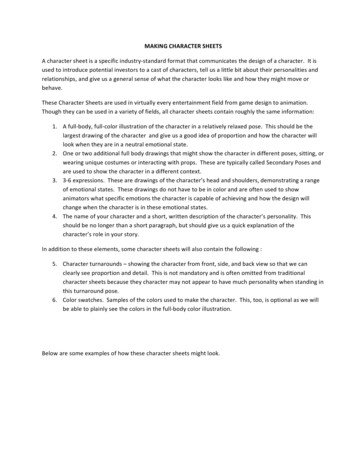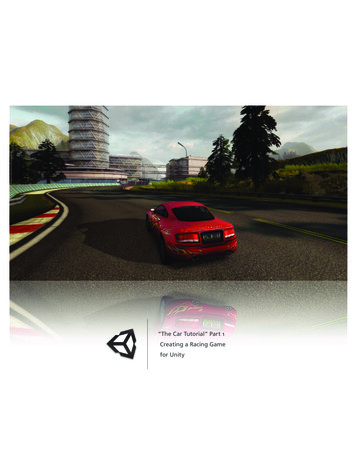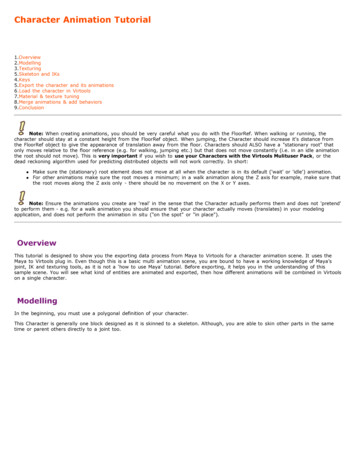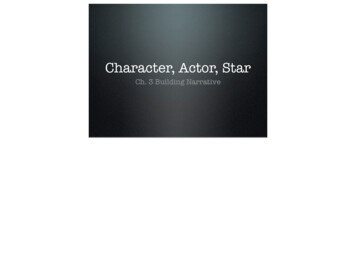
Transcription
Creating guidelines for game characterdesignsBachelor thesis in the subject of computer graphics artsClara LundwallComputer Graphic Arts, bachelor's level2017Luleå University of TechnologyDepartment of Arts, Communication and Education
Creating guidelines for game characterdesigns.Bachelor thesis in the subject of computer graphics arts.Clara LundwallInstitution for art, communication and teachingLuleå tekniska universitet, Skellefteå 2017Bachelor thesis 15 hpComputer Graphics Arts, Bachelor of Fine Arts 180 hp
PrefaceThis paper ends my three years of studies at Luleå University of Technology'scomputer graphics programme. Through these three years I have gainedknowledge in both VFX and game graphics, although my interest in the gameindustry has always been stronger. I’ve always had a large interest in artisticaspect of games, the visual experience and not so much the technical process. Sothe direction of my thesis, writing about design rather than technique, felt quiteobvious.Character design is the subject of this thesis. The subject of character design hasalways been interesting to me, and choosing a subject that is interesting and thatI already have some basic knowledge about for this thesis felt like a good choice.For the duration of this last course I have been working as an intern at ParadoxArctic in Umeå, where I also did practical work on a character for games.Although related to the subject of character design, this is not something I willdiscuss in this thesis.Clara Lundwall
AbstractThis thesis will address the subject of character design for games. I will look intodeveloping a method for creating a design template that one can use as basicguidelines when designing a character. The thesis includes research workrevolving the subject of how shapes and colors are used to convey a gamecharacter’s personality and identity without dialogue or context. How the use ofdifferent poses and combinations of lines and shapes help define a character andthe essence of the characters role in the game.The essay includes the creation of a module, how it would be used in a characterdesign pipeline, and also ideas on how the module could be further developed.The module is tested by being used to create three different characters and theresult is presented along with an evaluation of the usability of the module in adesign pipeline.The summary and discussion includes how the module might be useful for lessexperienced artist, whilst redundant for the more experienced. How the modulegave an initial boost and starting point in the designing of the three characters inthis essay is also discussed.SammanfattningDenna uppsatts kommer att behandla ämnet karaktärsdesign för spel. Jagkommer att undersöka hur man utvecklar en metod för att skapa en designmallsom man kan använda som grundläggande riktlinjer när man utformar enkaraktär. Avhandlingen innehåller forskning som undersöker hur former ochfärger används för att förmedla en spelkaraktärs personlighet och identitet utandialog eller sammanhang. Hur användningen av olika poseringar ochkombinationer av linjer och former hjälper till att definiera en karaktär ochkaraktärens roll i spelet.I uppsatsen ingår skapandet av en modul, hur den skulle användas i enkaraktärsdesign pipeline, och även idéer om hur modulen skulle kunnavidareutvecklas. Modulen testas genom att användas för att skapa tre olikakaraktärer och resultatet presenteras tillsammans med en utvärdering avmodulens användbarhet i en designpipeline.Sammanfattningen och diskussionen behandlar hur modulen kan varaanvändbar för mindre erfarna konstnärer, samtidigt som den kanske äröverflödiga för de mer erfarna. Hur modulen gav ett första steg ochutgångspunkt i utformningen av de tre karaktärerna i denna uppsats diskuterasockså.
Table of urposeQuestion formulationLimitations2.1Characters2.2Colors and shapes2.3Designing for games2.4The design process2.5Parameters for the module2.5.1 Genre2.5.2 Character identity2.5.3 Game view2.5.4 Character mood2.6Creating the module33.13.23.344.14.24.355.15.26MethodTesting the moduleDesign theme chosenCreating three charactersResultCharacter 1Character 2Character 3DiscussionConclusionFor the 4
1 Introduction1.1 BackgroundThere are two ways of conveying information about a character. Explicitcharacterization, which is when the audience is told what the character is like,through narration or dialogue. Or implicit characterization, that is when thecharacters information is given to be interpreted by the audience through thecharacters actions, manners, interaction with other characters, speech andchoice of words, and also the characters physical appearance. The last one, is theone which this thesis will be focusing on. Conveying a character's personalitythrough its physical appearance, specifically, a character for games.The task of creating a character design for games is often assigned to a conceptartist. The concept artist will through sketches, paintings, model sheets andother references create an image of what the character will look like in the finalgame. Based on information about the game, the characters story, and otherparameters given by the game designer. The concept is then used by game artistsfor the actual creation of the character inside the game(modeling, texturing etc.).There are a lot of guides and tutorial for character design currently, and a lot oftheory and research work on shapes, colors and silhouettes. And also manyguides and tips on how to combine these two areas of knowledge and research tocreate a specific character, and summaries on what is important when creating acharacter design.So my idea was to attempt on gathering some of this information and composingit into a matrice in which one can pick the traits of the character that is going tobe designed and get a sort of summarized design template. The design templatewould then be used as inspiration, guidelines or a quick way to get started in thecharacter design pipeline.1.2 PurposeThe purpose of this thesis is to investigate whether a module that generates adesign template can benefit the concept artist when designing a character. To seeif the task of designing a character can be made easier, or if the generatedtemplate can work as an inspiration source, guideline or starting point.1
1.3 Question formulationIs it possible to create a module for generating a design template that can beused when designing characters for a game? If parameters like game style, gameview, character identity and character mood were put into a module thatcontains some basic guidelines for designing a character with those parameters.Could a concept artist use these guidelines when creating a concept for acharacter? Will it benefit the pipeline in any way?1.4 LimitationsThis thesis will be focusing on the visual design of a character, not the writing ofa character and it’s personality. I will focus on creating a module containing fourdifferent parameters. Game style, character identity, game view and mood.Within these parameters i will cover 3-4 different directions. For example, withinthe “character identity” parameter I will cover the identity of a game protagonist,antagonist, supporting character and NPC/fill character.The plan is that the module should be eligible for extension, and that this will bea base only to see if it will provide the wanted results.2
2 Theory2.1CharactersCharacter are found in all kinds of medias and forms, in all stories and narrativework. They are what creates and drives a story in a book, movie, theatre play orgame. And during the last couple of years, the amount of game characters beingcreated has increased as the game industry has grown.The amount of new characters and character design needed for all these gameshas grown vastly. Trying to come up with a good and unique design has becomeharder, especially the latter one. I'm not claiming that character design waseasier before, but creating a character that stands out has become a much deepertask. It takes a lot more than just giving the character a crazy hair color anddramatic scar to make it memorable and unique to all the other existingcharacters.Creating a successful character is hard and will always be hard and require a lotof practice and research. There won't be any automatic solution of generating acharacter, it takes talent and time.2.2Colors and shapesEvery time someone is introduced to a new person, they automatically get theirown impression of the person quickly based on what they know from peoplethey've met before, and things they know from before. The impression might bewrong, or get changed as more information about the person is revealed, but thefirst impression of a new person will always be important (Haake, M. & Gulz, A.2008) .Not using this as an advantage when designing a character would be a waste.Playing on preconceptions, symbolism, allegory and alliteration in a subtle wayto show some of who the character is and making sure the audience gets theright first impression will do a lot for the story. But keep in mind, that themeaning of different symbols, shapes and colors may not be universally (RobhRuppel, 2014).ColorsColor, especially, have different meaning in different parts of the world. In aBBC’s production Horizon, they find that depending on people's formerexperience of the color, they will perceive and interpret it differently (SophieRobinson, 2011).3
One way to get around this could be to not assume that one color has samemeaning everywhere, but to at least use it for the same intentions and elementswithin the universe that the designed character resides.One aspect of color that has to be considered is the saturation. The use of morevibrant colors versus desaturated colors is a good way to create an interestingcontrast in a character.In an artguide posted on Dota2 workshop forum (Valve Corporation, 2015), theydiscuss the use of value and saturation to create visual interest. Their theory oncolor saturation is to avoid using large amount of highly saturated colors, onlyuse these small details to reinforce visual interest. “Less is more”, is used todescribe the use of saturated colors in this artguide. (Figure 1)Value, the balance between dark and bright, is also an aspect to consider.Contrast between dark/black and bright/white should be used on the characterin a way that defines the characters important features, separating and definingthe face and other important attributes from the less important parts. (Figure 2)Figure 1: Example for the use of saturation. Highly saturated (left) versusdesaturated colors(right)(Valve Corporation, 2015)Figure 2: Example for the use of contrast in values to highlight various shapes inthe design (Valve Corporation, 2015).ShapesThe primary shapes used to design a character's silhouette are circles, squaresand triangles. These have a much more universal meaning to them, because theirmeaning has its roots in nature rather than culture (Figure 3).4
Rounder look friendlier and softer because they almost always are, like flowers,cotton or smooth rocks. Which makes round shapes appropriate for thecharacter that are supposed to feel likable, friendly and good hearted.The square shapes are found in more robust objects like mountains, rocks andcliffs. Square shapes represent something steady, robust and reliable. This makessquares useful to character that are to be perceived as just that, steady andstrong.And then we have triangles, which in nature are sharp and edgy to the touch.These shapes are the ones communicating most caution. Triangles form sharprocks, thorns, teeth, and the classic shark fin. Using these to enhance acharacter's evilness or dangerous traits would be a good use of shapes (HannaEkström, 2013)Figure 3: Examples of the three shaped found in nature.2.3Designing for gamesWhen designing for games, there are a lot of limitations and other aspects tokeep in mind. Just as in designing characters for hand drawn cartoons, where thecharacters shapes should for example be easily drawn from all angles and alsoeasy to repeatedly draw, game characters also have some demands on them.Depending on what medium the character will be presented in, the design and itslimitation can differ greatly. Games that are to be played on smartphones andother similar devices will have to be a lot smaller in resolution and polygoncount and not as demanding in prestanda as games played on computers. Thiswill create a limit in polygons, texture sizes, the use of dynamic materials such ashair and cloth.Keeping this in mind during the character design is important. Creating a highlyrealistic and detailed design and then trying to convert it into a character playedon a 5 inch screen could turn out to be hard and eventually not result in a goodlooking and readable character.5
Another limit that game characters have is the amount of dialogue and text thatcan be used to present the characters personality and backstory. The time andinformation needed to get to know a character is limited comparing to a movieor in a book, and that's why the design sometimes need to step in and fill in someof the information. Instead of hearing a long intertwining story about, forexample, the characters rough and dangerous background, it can be told bygiving the character an old scar or missing limb perhaps (Robh Ruppel, 2014).Also, making use of the stereotypes that exist in different medias to some degree,will fill in the gaps that the story or dialogue doesn't tell. Visual stereotypes are apart of our social autopilot, they build up common references and suggests traitsof the character used for understanding and predicting the character and itsactions (Haake, M. & Gulz, A. 2008).2.4The design processSince every artist has a personal preference in the method of creating andworking on their designs, the pipeline for the design process isn't anything thatcan be decided or named as “the best way”. Developing a pipeline fit for how oneworks based on what steps it should involve is the best way. After researchingother artists pipelines (Arnold Tsang, 2014)(Lars Martinsson, 2014) andcomparing it to how I'm used to work I've come up with my own pipeline that Iwill use for this project. It’s based on three steps, which I will go into in thissection.ResearchStudy the type of character that's going to be designed. Having keywords is agood start when searching for inspiration and references. The charactersdescription and story should be the main source of inspiration and informationfor the character design.Get a good understanding of whom and what the character is going to be in thegame. What is their backstory, goal, personality etc. Knowing the “what” and“who” is important before starting to create the visual representation of thecharacter. Always base the design choices in something tied to the charactersstory or function. It's important to have a reason behind the design choices, keepasking “why” when developing the character. So this step is mainly aboutgathering inspiration, references and information about the character in form ofpictures, sketches and keywords.6
ConceptBased on the references and keywords found and gathered during the researchstage, continue with drawing small sketches and thumbnails. It's a good way toget the creativity flowing and to get all initial ideas down quickly without havingto spend time and drawing them correctly.At this stage, no idea is a bad idea, everything is worth doing a sketch of. Trydrawing different shapes and silhouettes and see what mediates the characterspersonality in the best way. At the end of this stage there should be a fewdifferent variation of designs, no details are needed just the basic shapes, colorsand silhouettes.FinalizeStep back and look at the different ideas and thumbnails that have been created.Evaluate what seems like a good idea and what doesn't. When looking at all ideasas a whole it’s easier to see what stands out and what seems more interesting.Choose a few of these, maybe two or three, and do further work on them. Definethe silhouettes and lines in the design and make it readable. Work on creating abelievable anatomy and proportions. Try out different poses to see how thecharacter acts. Will the character be able to perform the movement andexpressions it should? Does it still fit to the description of the characters role inthe game? Explore details, colors, materials, hair and other elements to thedesign. A finished concept usually contains a full model sheet. A model sheetusually contains the characters appearance, different views (side, front, back) ofthe character, material reference and other information needed by the gameartists to create the character.2.5Parameters for the moduleThis section will introduce the parameters that will be included inside themodule created for this thesis, along with examples from existing game characterfrom various games.2.5.1 GenreRealisticCreating a game in a realistic style puts more demands on both artist andhardware performance. In order to recreate the reality as close as possible,games with higher polycount, higher resolution textures, more dynamicsimulation etc. are the ones that comes closest to achieve just that.7
The use of reference from real life becomes highly important and creating assetsand designs purely from imagination almost always results in flaws in realism.When it comes to creating characters in a realistic style this is extremely vital.For the character to be believable and to avoid the uncanny valley, references ofhuman and animal anatomy should be used and considered at all times. Even ifthe creature itself may be made up, using existing creatures and their functionsand anatomy build as a reference of how the invented creature would move andfunction is highly recommended.Semi-realisticThis level of realism and style invites more creative freedom for both conceptartists and graphic artists. Having realistic proportions and references to real lifeanatomy when designing characters is still recommended for semi-realistic style,but features can be exaggerated or altered to better enhance the visual appealwithout needing to be truly realistic.StylizedGames that don’t strive for realism can be categorized as stylized. They havetheir graphical design based on visual appeal in first hand rather than realismand realistic credibility. These games concept artist have much higher creativefreedom, but still some constraints. As with all games, it's important keeping aconstant visual theme throughout and having art style guidelines that theconcept artists and graphic artist can work within. A few common elementsfound in stylized games are exaggerated proportions, bold colors, cel-shading,retro influences, geometric shapes and many more.2.5.2 Character IdentityThe protagonistThis character should stand out against other characters in the game. Givingthem attributes that no other character has, and a more unique silhouette andcolor scheme. The character should be easily recognized and distinguished fromthe rest of the crowd of game characters.Since the hero will be the player's avatar when experiencing the game, being ableto relate to this character and feeling like one owns it is important. Making thecharacter feel familiar and likable could favor the players relation to thecharacter and by that also enhance the experience of the game.8
The character is a player's tool and the player channels all their actions throughthe game character (Manninen, T. & Kujanpää, T., 2007)Something that really help with the feeling of owning and bonding with acharacter is to have some customizable options. It could be as immersive anddeveloped as in games like Skyrim or Black Desert, where everything betweenheight, hair color or shape of the nose can be customized. Or simplercustomization, as being able to change the color of the clothes and weapons thecharacter is carrying, as in Blizzard's game Diablo 3.Shapes often found in this type of character are typically rounder and smoother(Figure 4) to seem friendly. Giving the character a visible and friendly face alsogives the player a slightly bigger chance to bond with them.Figure 4: Silhouettes of three moderately well know game protagonists. (Zelda,Banjo & Kazooie, Samus Aran from Nintendo Co.)The antagonistDefeating the villain in the game is what should drive the player to play thegame. Having an uninspiring and unchallenging villain that doesn't provide thatinterest will make the player lose interest in the goal of the game (Manninen, T.& Kujanpää, T., 2007). The protagonist doesn't necessarily have to consist of onespecific character, many games use other villain in the form of situations,obstacles or other inanimate enemies. But for the more classic bad guy design,there are some general guidelines commonly used within the design. Having anunlikable protagonist is something that will help with driving the player’smotivation to defeat them. The contrast between the protagonist and antagonistdesign should be defined, show the opposites and make them easily recognized.In general, the story of the game is driven by the antagonist and protagonist’srelation, to their differences and disagreements. So visualizing their oppositescan help with understanding the story without having to explain it.9
When designing a villain, there are a lot of different looks to approach, but someof the most common ones are the ones made up by hard and heavy lookingshapes. Squares and triangles, sharp and spiky edges (Figure 5). The reason forthis kind of design is to make the character unmistakably evil. To be able toidentify the character as the villain without hearing a whole lot of plot andbackstory. Designing the villain is as vital as designing a good protagonist, thecontrast and battle between them is what makes up the main goal and story ofthe game.Figure 5: Silhouettes from three moderately well know game antagonists.(Samus Aran, Banjo & Kazooie from Nintendo Co. - Diablo 3 from BlizzardEntertainment)Supporting characterThe supporting character can be as unique as the protagonist, since it can oftenserve as an extension of the hero. If the role of the supporting character is therole of a companion, then the player is often meant to feel a connection to thecompanion and feel somewhat responsible for them. They often work as anextension of the main character to help drive the story and game forward orgiving the task and challenges more meaning. Giving the supporting characterattributes criteria’s as the protagonist is often done. Softer shapes and friendlyfaces can be found in this type of character (Figure 6).10
Figure 6: Three examples of Supporting characters from different game genres.(Samus Aran, Banjo & Kazooie from Nintendo Co. - Witcher 3 from CD ProjektRED)NPC/Fill characterThese are the “filler” characters of a game. Common inhabitants or enemies inthe game world. Their purpose could be to serve as either quest givers, differenttypes of enemies, or minor roles to give a more lively feeling to the environment.They usually don't contribute to the story as much as the main characters do.These characters are usually much simpler and less unique than the othercharacter in the game. This is sometimes due to the time and size restraint gameproductions have. Time and work is usually spent on the more importantcharacter, and a few versions of NPCs are created then used multiple times in thegame.These characters are typically based on simpler designs with less details andunique features to help with separating the main characters from the crowd.2.5.3 Game viewTop down viewAccording to Dota 2's character art guide(Valve Corporation, 2015), whendesigning character for games using top down view the concept of a goodsilhouette, along with good use of detail becomes more important. Since thecharacter will be viewed from a distance and a fixed camera angle, a recognizablesilhouette is what will distinguish the many characters in a game from eachother.Another important part of designing for top down is knowing where to placedetails, and how much details to use. Make sure the details that are used are areasonable size, if they are too small they won't read well at a distance and willonly be perceived as noise. Also make sure to leave larger areas without detailsto give the eyes some areas to rest.11
These areas don't necessarily have to be one colored and flat, but subtle detailsand softer color differences could be used to still keep the area simpler andeasier on the eyes. (Figure 7) Focus will almost always be above waist on thecharacter in this view, so those are the part that the focus of the designer shouldalso lay on.Figure 7: Example of detail placement and areas of rest. The red marks wheredetails are focused.Green marks where areas of rest are used. Also, example of characters viewed intop down view. (Valve Corporation, 2015)3rd person viewCharacters seen from third person view will be available for more detail than topdown view. This applies for both the character one plays as, and other charactersin the game since they will also most times be seen from close up (Arnold Tsang,2014)They also often require to be more dynamic and interesting to look at since theywill most of the time be seen more continuously and in a bigger scale thancharacters in top down view. Looking at the back of the character during a longergame session in 3rd person view can be tiring if the design isn't interestingenough. This also goes for the animation which can be made more dynamic andinteresting by for example adding animated cloth, hair or other simulations, andalso by having parts or assets on the character that receives secondarymovement. These sorts of attributes can be found in many 3rd person viewedgame characters. For example, Geralt from The Witcher game series (Figure 8).The two sword always carried by this character makes for an interestingsilhouette, and also provides secondary movement as the character moves. Andthe hair provides an even more interesting look with its dynamic movements.12
Figure 8: “Geralt of rivia” (Witcher 3 from CD Projekt RED)Side ViewAs with top down view, side view also requires strong silhouettes. Apart fromthat, one of the main aspects needed for side view characters, is the ability to beviewed equally clearly from both sides. Having some major accessory, like a cape,that could cover the character from one angle might not be a good choice andsomething to avoid. Poses for the character also become more important in sideview, for the same reason. A pose when the character faces right on the screenmight not work as well when the character is turned around to face left (ArnoldTsang, 2014). One example of a well know character from a side-view game isRyu, from the “Street fighter” series (Figure 9).Figure 9: The character “Ryu”. (Street Fighter from Capcom)13
2.5.4 Character moodUse the characters looks to enhance their personality and what they are feelingwill lower the need for long dialogues about it. Mediate the characters storythrough color, shape and pose. Poses is the way the character is presented, thecharacters mood will be easily read from its pose. As in theatre, dance and otherperforming arts the pose involves every part of the body. Conveying a messageor emotion relies heavily on poses and silhouettes (George Maestri, 2001).One of the most powerful languages is the body language, and what itcommunicates best is feelings. So using strong body language to communicatethe character's mood is a good way to express their personality and goals. Strongbody language can also work as substitute for lots of dialogue. For example,expressing surprise or disappointment can be done easily through bodylanguage instead of having the character explaining its feelings in dialogue (LesPardew, 2008).Angry/intenseAs stated before, colors can mean different things in different parts of the world.But some facts about color stay the same. For example, red. Red is a vibrant colorused by both nature and people as a warning color. This also makes it a good fitfor intense or strong feelings.It’s an intense and stimulating color, which makes it appropriate for intensecharacters.Strong and powerful poses are also found in this type of character mood. A goodexample of this character mood is the protagonist from God of War, Kratos(Figure 10). He has a strong and fierce pose making him come off as intense orangry. He’s design also contains some red element, which enhances this.14
Figure 10: The character “Kratos” (God of War from Sony ComputerEntertainment).Sad/melancholySome general characteristics of a sad or mellower pose are drooping shoulder,limbs closer to the body and head down. Using these kinds of traits anddownward drooping shapes and lines will make the character seem fragile andbe more available for sympathy.The color to work with to enhance the feeling of sadness often includes darkerand more desaturated colors. Blue is commonly known as a color appropriate forrepresenting sadness or calmness, but as stated before, the meaning behind itcan vary. One example of a sad/melancholy character is the character “Amumu”from Riot games “League of Legends” (Figure 11). The desaturated blue tones,down tilted head and closed pose make the characters mood easy to identify.Figure 11: The character “Amumu”(League of Legends from Riot Games).15
Happy/lightIf the characters mood should represent happiness or lightness of some kind, it'sbasically the opposite of the characteristics for sadness. Upward facing andpointing lines, limbs posed more spread, and head facing outward to itsenvironment. This will make the character feel confident and moreexcited/happy.Same goes for colors. Bright, vibrant and more stimulating colors are usuallyused to communicate the
The task of creating a character design for games is often assigned to a concept artist. The concept artist will through sketches, paintings, model sheets and other references create an image of what the character will look like in the final game. Based on in










